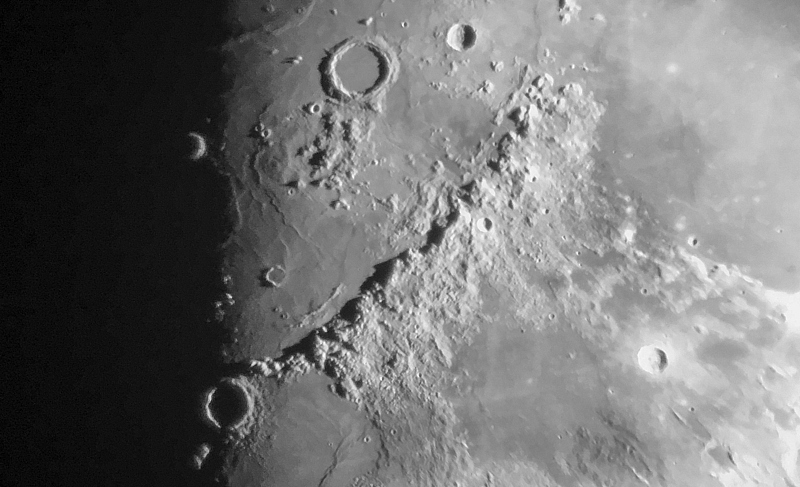Opening the Observatory (video), iPhone 6s Plus Lunar Imaging
Posted: 17 March 2016
Tuesday, 14 March 2016, was partly cloudy during the day and became overcast in the late afternoon. Wednesday, 16 March, was mostly clear, with a clear forecast for the night.
Received good news on Tuesday: the PZT Hardware Kit will be shipping soon.
|
Open: Wednesday, 16 March 2016, 1808 MST Temperature: 90°F |
Session: 935 Conditions: Clear |
I first set up the iPhone 6s Plus on the observatory patio to record a time-lapse video of opening the observatory and doing some initial observations with the 12" LX600 telescope. The iPhone was mounted on a photographic tripod using the Orion SteadyPix Universal Smartphone Telescope Photo Mount. I started the video recording shortly before sunset and continued it for about 35 minutes (using the "time-lapse" feature of iOS 9).
1820 MST: began opening the observatory. Set StarLock OFF. Did a GOTO the Moon and viewed it at 102X. Then added the Televue 2X PowerMate for some brief lunar observing, 203X. Then back to 102X and went to the star Sirius. 1833 MST: watched a flight of two Osprey aircraft fly over the observatory. 1835 MST: sunset. GOTO M42 (Orion Nebula); the Trapezium stars were visible against the bright sky, 102X. 1843 MST: back to Sirius and did some collimation checks with and without the star diagonal using the Baader Zoom 8-24mm Eyepiece at 8mm (305X). The technique used was described in the October 2013 issue of Sky & Telescope magazine. No collimation error was seen with or without the star diagonal. 1854 MST: GOTO Jupiter, low in the eastern sky, and observed it using 102X. The four Galilean Moons were visible.
1857 MST: ended time-lapse video recording. To view the video (34 seconds, 14.3 MB) click the image below:

Click or tap on image for video
1906 MST: back to the Moon. Switched to the OPT 2" 30mm (81X) in order to get the entire lunar disk in the field-of-view of the iPhone camera. This is a handheld iPhone 6s Plus afocal photo of the Moon, 81X:

Switched to the 8-24mm zoom eyepiece and did some lunar observing. Then returned to Jupiter, which was still too low in the eastern sky for good viewing. Could only use the zoom eyepiece at 16mm (152X). 2009 MST: Jupiter higher now; could use 12mm (203X). 2040 MST: finally Jupiter was high enough to tolerate viewing at 8mm (305X).
2044 MST: returned to the Moon and did some more lunar observing, 305X. Took these handheld iPhone 6s Plus afocal 305X photos, both slightly cropped:
Straight Wall

Montes Apenninus

Added the Televue 2X PowerMate to the zoom eyepiece. Did more lunar observing; 604X. At times the views were very impressive using the theoretical maximum usable magnification for a 12" telescope. Will have to consider getting a 4mm eyepiece at some point. Decided to try using the zoom eyepiece with the Meade 3X TeleXtender. With the eyepiece at 8mm focal length, viewing at 914X was actually pretty nice at times.
2114 MST: last look at Jupiter.
|
Close: Wednesday, 16 March 2016, 2129 MST Temperature: 60°F |
Session Length: 3h 21m Conditions: Clear |
Comments are welcome using Email. Twitter users can use the button below to tweet this report to your followers. Thanks.
Cassiopeia Observatory Home Page
Copyright ©2016 Michael L. Weasner / mweasner@me.com
URL = http://www.weasner.com/co/Reports/2016/03/17/index.html
